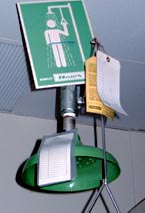Emergency Procedures
For Spills or Medical and Fire Emergencies:
Dial 911
Your Location is: #10 East Mall,
Geology Building
911 from a campus phone will connect you to the UTPD emergency dispatcher
(471-4441 on a cell phone).
9-911 will connect you to Austin Travis County Emergency Dispatch and NOT UTPD
(911 on a cell phone)
Department Safety Contact:
Emergency Procedures
Building Evacuation Plan
Material Safety Data Sheets: MSDS ONLINE
FIRE:
- In the event of a fire, pull the nearest fire alarm pull station.
Dial 911 from
a safe location and state you have a fire, then give the nature and the
extent of the emergency; be as specific and detailed as possible.
- If you are unable to easily control or extinguish the fire, evacuate
the building. Do not expose yourself to undue risk. Stay between the
fire and your exit.
- Notify UTPD by calling 911 from a campus phone, or dial 911 on your
cell phone to notify Austin Fire Department.
Medical Emergencies :
- Call 911 and request an ambulance, then give the nature and the
extent of the emergency; be as specific and detailed as possible. Then
call UTPD at 911 and tell them if you have already requested an
ambulance.
- If trained, provide appropriate assistance, but do not delay
activating the 911 system.
- Notify the front office at 1-5172. If additional people are
available, notify Phil Bennett at 1-3587
Chemical Exposure:
- For all exposures, call UTPD at 911.
- Attend to any person(s) who may have been contaminated and/or
injured if it is safe to reach them.
- Use safety showers and eyewashes as appropriate. Safety showers are
located in GEO 6.310; the second floor Women's bathroom, and the basement
Men's bathroom.
- In the case of eye contact, promptly flush eyes with water for a
minimum 15-minute period and seek medical attention immediately.
- For ingestion cases, call 9-911 immediately.
- In case of skin contact, have the victim promptly flush the affected
area with water and remove their contaminated clothing or jewelry. Seek
medical assistance.
- Notify OEHS (1-3511).
Chemical Spills:
For all spills,
- Determine immediately if there was any chemical exposure and treat
appropriately
- Notify persons in the immediate area about the spill and evacuate if
necessary.
- Notify the OEHS Hazardous Materials Division (1-3511).
For large spills,
- Call 911
- Evacuate all non-essential personnel from the spill area and adjoining
areas that may be impacted by vapors or a potential fire. Don't forget the
room immediately below the spill area - liquids can leak through the floor.
- If the spilled material is flammable, turn off all potential ignition
sources.
- Avoid breathing vapors of the spilled materials. Be aware that some
materials either have no odors or create olfactory fatigue, so that you stop
smelling the odor very quickly.
- Leave on or establish exhaust ventilation if it is safe to do so. Close
doors to slow down the spread of odors.
- Prevent reentry to the affected area until the arrival of UTPD and/or
OEHS.
For Small spills,
- Use a spill control kit appropriate to control material spilled, if
appropriately trained to respond. Determine the appropriate cleaning method
by referring to the MSDS.
- During cleanup, wear appropriate protective apparel, at least chemical
resistant gloves and goggles.
- Cover liquid spills with compatible absorbent material such as spill
pillows or a kitty litter/vermiculite mix. Be sure to check compatibility.
If appropriate materials are available, corrosives should be neutralized
prior to absorption. Clean spills from the outer areas first, cleaning
towards the center.
- Place the spilled material into an impervious container, seal, and
contact OEHS for disposal. If appropriate, wash the affected surface with
soap and water. Mop up the residues and containerize for disposal.
